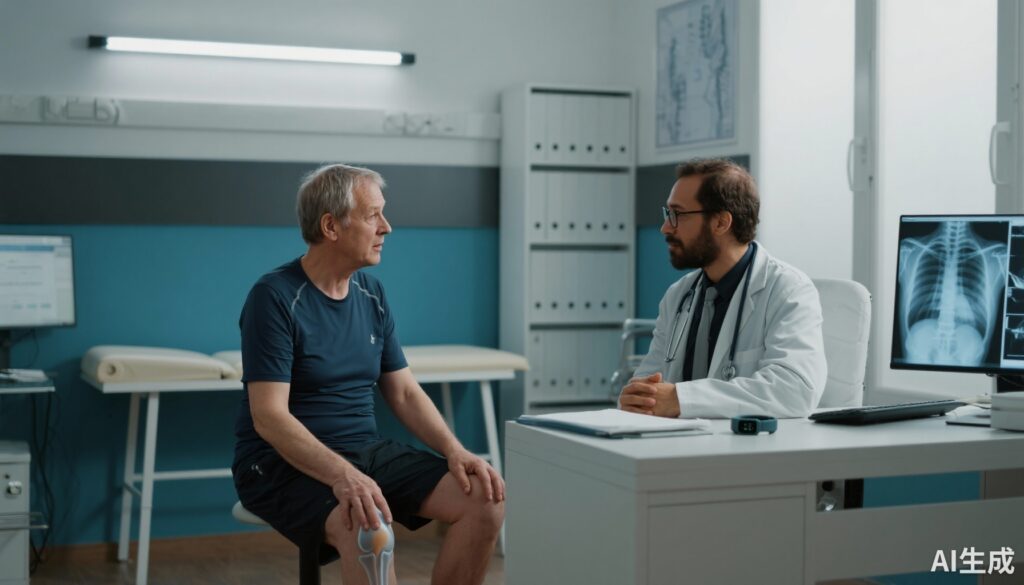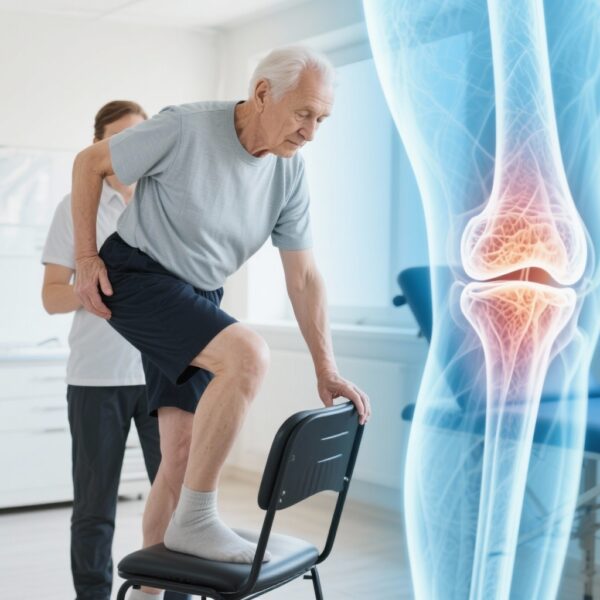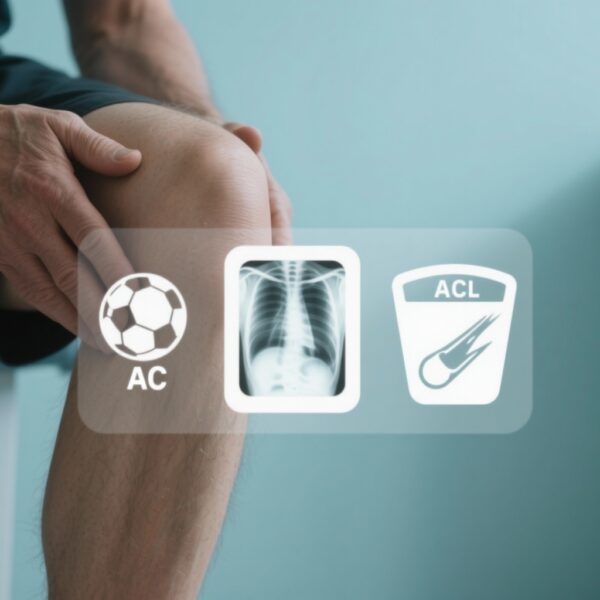Highlight
Key points
• In 2,534 OAI participants with radiographic knee osteoarthritis (KL ≥2), baseline self-reported moderate physical activity (PASE tertile) was associated with a substantially lower subdistribution hazard for OA-related primary knee replacement among knees with KL grade 2 (adjusted HR 0.38, 95% CI 0.20–0.73) over 108 months.
• Conversely, among participants with KL grade >2, moderate activity was associated with a higher risk of OA-related knee replacement (adjusted HR 1.46, 95% CI 1.08–1.97); high activity showed no consistent benefit or harm in either stratum.
• The association between activity and surgical outcome varied by baseline radiographic severity; competing risks methods and stratified analyses were used to address death and non-OA knee replacement as competing events.
Background
Knee osteoarthritis (OA) is a leading cause of pain, disability, and joint replacement worldwide. Conservative management—particularly exercise and weight management—is a cornerstone of guideline-recommended care for knee OA because it reduces pain and improves function. However, whether higher levels of habitual physical activity alter long-term structural outcomes or the ultimate need for total knee replacement (KR) remains uncertain. Observational data provide mixed signals: some studies suggest that activity is neutral or protective, while others raise concerns that high or inappropriate joint loading may accelerate progression, particularly in advanced structural disease.
Understanding how baseline physical activity relates to the eventual need for OA-related knee replacement—and whether this relationship differs by radiographic severity—has direct clinical relevance. It can inform personalized counseling on activity type, intensity, and load management across the spectrum of knee OA severity.
Study design
This analysis used prospectively collected data from the Osteoarthritis Initiative (OAI). The analytic sample included 2,534 participants with radiographic knee OA in at least one knee (Kellgren and Lawrence [KL] grade ≥2) who completed the Physical Activity Scale for the Elderly (PASE) at baseline.
Exposure: Baseline self-reported physical activity measured by the PASE and categorized into tertiles (low, moderate, high).
Outcome: Primary knee replacement (KR) performed for OA over a 108-month follow-up. Non‑OA primary KR and death prior to KR were treated as competing risks.
Statistical approach: Both cause-specific hazard models and Fine–Gray subdistribution hazard models were fitted. Models adjusted for demographic factors (age, sex), body mass index (BMI), race and education, income categories, baseline WOMAC pain, knee alignment, bilateral OA involvement, and prior knee injury or surgery. Because KL grade violated proportional hazards and interacted significantly with PASE (P < 0.001), analyses were stratified by baseline KL grade (KL 2 versus KL > 2).
Key limitations of exposure: PASE is a validated self-report instrument for older adults but captures only baseline activity and is subject to recall and misclassification bias. The observational design limits causal inference.
Key findings
Follow-up and events: Over nine years, 372 participants underwent primary OA-related knee replacement.
Interaction with radiographic severity: The effect of baseline physical activity on OA-related KR risk was strongly modified by baseline radiographic severity (KL grade).
KL grade 2 (milder radiographic disease)
In subdistribution hazard models that account for competing events, moderate baseline physical activity (middle PASE tertile) was associated with a markedly lower risk of subsequent OA-related KR compared with low activity (adjusted subdistribution HR 0.38, 95% CI 0.20–0.73). This suggests a 62% relative reduction in the subdistribution hazard of KR over 9 years for people with KL 2 reporting moderate activity at baseline.
High activity (upper tertile) did not demonstrate a clear statistically significant association with KR risk (adjusted HR 0.86, 95% CI 0.49–1.50), indicating imprecision around benefit or harm at higher self-reported activity levels in this subgroup.
KL grade > 2 (more advanced radiographic disease)
By contrast, among participants with KL grade >2, moderate baseline physical activity was associated with a higher risk of OA-related KR (adjusted subdistribution HR 1.46, 95% CI 1.08–1.97). High activity showed an attenuated and statistically non-significant trend in the same direction (adjusted HR 1.33, 95% CI 0.94–1.88).
Consistency and robustness
Cause-specific hazard models (which estimate the instantaneous event rate in those still at risk) produced similar results to the subdistribution models, strengthening the observation that radiographic severity modifies the activity–KR association. Adjustment for multiple clinical and sociodemographic covariates and the use of competing risks methodology are analytic strengths.
Interpretation of effect sizes
The large magnitude of the protective association observed in KL 2 for moderate activity (HR 0.38) suggests clinically meaningful differences in long-term surgical risk linked to baseline activity. However, potential residual confounding, measurement error in self-reported activity, and reverse causation—whereby less symptomatic people are more active—must temper causal claims.
Expert commentary and contextualization
How should clinicians interpret these findings? The study contributes an important nuance: physical activity is not a uniform exposure with uniform downstream effects. Radiographic severity at baseline appears to modify the relationship between activity and the need for knee replacement.
Potential mechanisms:
• In earlier-stage OA (KL 2), moderate activity likely promotes muscle strength, neuromuscular control, and metabolic health, translating into better pain control and functional reserve that may delay progression to end-stage disease and the need for arthroplasty.
• In more advanced structural disease (KL >2), moderate activity may reflect higher symptomatic load or more frequent high‑impact joint loading that accelerates joint failure in vulnerable knees. Alternatively, people with advanced disease who remain active may have different thresholds or access patterns for surgery.
Compatibility with guidelines and trials: High-quality randomized trials and systematic reviews consistently show that structured exercise (land- and water-based strengthening, aerobic and neuromuscular training) reduces pain and improves function in knee OA (e.g., Fransen et al., Cochrane reviews). Professional guidelines—including the 2020 ACR/Arthritis Foundation OA guideline—strongly recommend exercise and physical activity as central components of OA management. The current observational findings do not contradict these recommendations; rather, they suggest tailoring exercise prescriptions by disease severity and emphasizing load‑management strategies in advanced disease.
Limitations and alternative explanations
• Exposure measurement: Single baseline, self-reported PASE cannot capture changes in activity over time, activity type (impact vs non‑impact), or patterns (bouts, intensity), and may misclassify true exposure.
• Confounding and reverse causation: Individuals with less pain and better function are more likely to report higher activity and may also be less likely to progress to KR independent of activity. Although the study adjusted for baseline WOMAC pain and other covariates, residual confounding remains possible.
• Selection and generalizability: The OAI cohort has specific inclusion criteria; results may not generalize to other populations (younger patients, different comorbidity profiles, or geographic settings with different thresholds for surgery).
• Outcome definition: KR is a patient- and system-level outcome influenced by symptom burden, physician practice patterns, and access to care; it is an imperfect surrogate for structural progression.
Implications for practice
These results support a precision approach to activity counseling in knee OA rather than a one-size-fits-all message:
• For patients with earlier radiographic OA (KL 2): Encourage regular moderate-intensity, predominantly low-impact aerobic activity combined with targeted strengthening and neuromuscular training. These interventions are evidence-based for symptom relief and—per this analysis—may be associated with lower long-term risk of requiring knee replacement.
• For patients with advanced radiographic OA (KL >2): Emphasize careful load management. Recommend low‑impact aerobic modes (walking with pacing, cycling, aquatic therapy), graded strengthening focused on improving shock attenuation and control, weight management, and close symptom monitoring. Shared decision-making with individualized activity plans and thresholds for symptom-limited progression is key.
• Across all severity levels: Encourage maintenance of muscle strength and aerobic fitness, address comorbidities (especially obesity), and consider referral to supervised exercise or physical therapy to optimize technique and load distribution.
Research and measurement priorities
To move beyond the limitations of cross-sectional self-report, future work should:
• Use longitudinal and device-based activity measures (accelerometers, wearable sensors) to capture intensity, impact, and temporal patterns.
• Combine biomechanical assessment, structural imaging, and symptom trajectories to disentangle mechanisms linking activity to progression and surgical outcomes.
• Test targeted exercise and load‑management interventions in randomized trials stratified by radiographic severity to evaluate causal effects on structural progression and hard surgical endpoints.
Conclusion
In this large competing-risks cohort analysis from the OAI, the association between baseline self-reported physical activity and subsequent OA-related knee replacement differed by baseline radiographic severity. Moderate activity was associated with substantially lower KR risk in KL 2 but with higher risk in KL >2; high activity showed no clear effect. These findings underscore the importance of tailoring physical activity advice to disease stage, emphasizing strengthening and low-impact aerobic activity in earlier OA, and focusing on load management and weight control in more advanced disease. However, causal inference is limited by single-time-point, self-reported exposure assessment and residual confounding. Wearable-based longitudinal measurement and stratified interventional trials are needed to inform precise activity prescriptions that optimize long-term joint health.
Funding and clinicaltrials.gov
For funding details and trial registration information, please consult the original publication: Peng H, Cai Q, Liu D, Duong V, Oo WM, Zhang C, Hunter DJ, Zheng Y, Fu K. Self-reported physical activity and risk of primary knee replacement for osteoarthritis: a competing risks cohort analysis. BMC Musculoskelet Disord. 2025 Oct 27;26(1):1000. doi: 10.1186/s12891-025-09254-y. PMID: 41146133; PMCID: PMC12560333.
References
1. Peng H, Cai Q, Liu D, Duong V, Oo WM, Zhang C, Hunter DJ, Zheng Y, Fu K. Self-reported physical activity and risk of primary knee replacement for osteoarthritis: a competing risks cohort analysis. BMC Musculoskelet Disord. 2025 Oct 27;26(1):1000. doi: 10.1186/s12891-025-09254-y.
2. Washburn RA, Smith KW, Jette AM, Janney CA. The Physical Activity Scale for the Elderly (PASE): development and evaluation. J Clin Epidemiol. 1993;46(2):153–62. PMID: 8437038.
3. Kolasinski SL, Neogi T, Hochberg MC, et al. 2020 ACR/Arthritis Foundation Guideline for the Management of Osteoarthritis of the Hand, Hip, and Knee. Arthritis Care Res (Hoboken). 2020;72(2):149–162. doi:10.1002/acr.24131.
4. Fransen M, McConnell S, Harmer AR, van der Esch M, Simic M, Bennell KL. Exercise for osteoarthritis of the knee. Cochrane Database Syst Rev. 2015; (1):CD004376. doi:10.1002/14651858.CD004376.pub3.
Note: Additional background on the Osteoarthritis Initiative (OAI) cohort and dataset is available through the OAI public repository and associated cohort publications.



